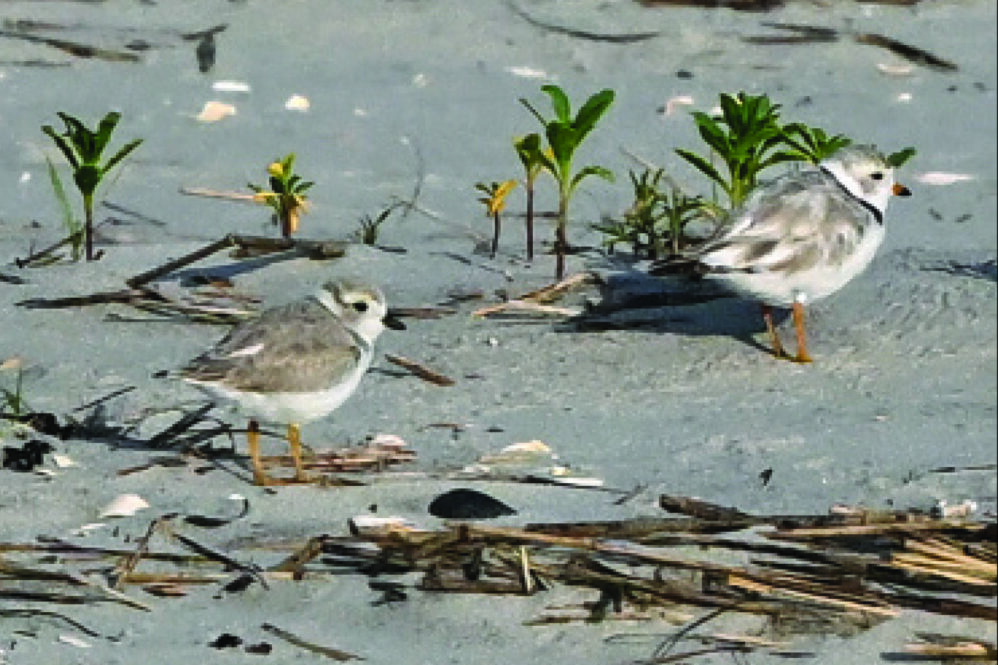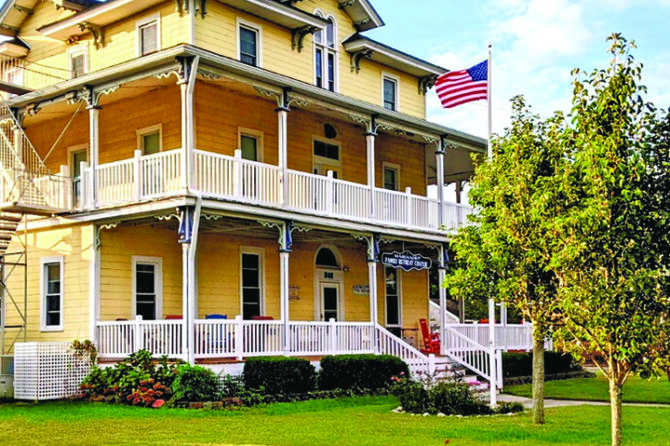Fledge rate is currently too low for endangered species’ recovery
WOODBINE — Life isn’t getting easier for endangered piping plovers in New Jersey. There was a 25 percent population drop from 2023 to 2024 and it appears the statewide numbers of nesting pairs will fall again this year.
The conclusion in the New Jersey DEP Fish and Wildlife Endangered and Nongame Species Program report for 2024 by Emily Heiser and Christina “Kashi” Davis was bleak.
“Piping plovers in New Jersey face insurmountable pressure that increasingly makes recovery a distant goal,” they wrote.
Interviewed at the end of August, as final statewide data are still to be fully tabulated, Davis, principal zoologist out of Woodbine, didn’t have any better news. Asked how their outlook was compared to their report last year, Davis said it was trending the wrong way.
“Even more so now, because we know no matter what the final number is, it’s definitely going to be lower than last year. So we are continuing to head in a direction that is not really tenable for recovery,” Davis said.
There were 89 pairs of piping plovers nesting in New Jersey in 2024, the lowest recorded number in the state since monitoring began in 1987. The peak population was 144 pairs in 2003, according to the report, and last year was well below the long-term average of 116 pairs.
Davis explained for the species to recover, each pair needs an average of 1.5 fledglings to survive, but the past two years it was .54 and .53 per pair, respectively. That means roughly one chick survived for every two pairs of piping plovers in each of the past two years.
There was a bright spot in Ocean City. One nesting pair in the north end dunes produced one fledgling.
“They made it, which was wonderful. They were only able to fledge one chick, but honestly, that’s pretty good for that site,” Davis said. Acknowledging the higher average, Davis points out in New Jersey, “particularly for highly recreated areas, if we can get one chick per pair, we don’t feel like it’s a total failure, even though we know it’s not what we need to have for recovery. If we can get one chick out of each pair, like that’s pretty great. Unfortunately, for that site, there was two pairs of piping plovers and the other pair lost their nest in a flood. So really for that site, it was one chick for two pairs, so that’s only 0.5, which is not great,” Davis added.
Piping plover chicks face a lot of barriers to survival.
“It’s really a mix and that’s part of the reason it’s so hard to recover them, because there’s not one thing to pinpoint and say, ‘OK, if we fix that, we’re golden.’”
The main issues are human disturbance, flooding and predation.
“Depending on the site and depending on the year, they can kind of switch around in order of which is the most dramatic and what the biggest problem is,” Davis said.
She pointed out human disturbance is the one aspect in which Fish and Wildlife has the best opportunity to influence.
“It’s very rare these days that we have a nest loss due to human disturbance, which is great,” she said. “We have areas fenced off. We have people out monitoring, patrolling and making sure that we’re not actually losing eggs to being run over, stepped on, purposely destroyed, that type of thing.”
There is a however.
Piping plover nests may be protected, but the little chicks have to feed themselves. The tiny creatures that look like cotton balls on toothpick legs have to get down to the wrack line to feed.
“And that’s really difficult … at sites that have a lot of human disturbance,” Davis said. Ocean-facing sites are not as advantageous for feeding as bayside sites, which are ideal, allowing the chicks to put the necessary weight on.
And then there are the predators. “Just about everything you can think of, avian and mammalian, is looking to get them, and invertebrates, too, because of ghost crabs.”
Add to that flooding, which will become even more pervasive along the coast as sea level continues to rise.
“It’s just very difficult for the birds to recover from (flooding events),” Davis said.
Cape May County
In the 2024 report, Heiser and Davis said Cape May County accounts for about 15 percent (13 pairs) of the nesting pairs of piping plovers statewide. The greatest number are in the Forsythe National Wildlife Refuge.
Peck’s Beach, which includes all Ocean City sites and Corson’s Inlet State Park, saw a decline from eight pair of piping plovers to six from 2023 to 2024. Stone Harbor Point had three pairs in both years and there was an increase from two pairs to four pairs at Two Mile Beach between the U.S. Coast Guard’s LORAN Support Unit and Cape May National Wildlife Refuge, according to the report.
Cape May County’s fledgling success rate improved year over year.
Davis said years ago the county had upward of 35 to 40 pairs of piping plovers, and preliminary numbers show 13 pairs in 2025.
“Cape May County is actually going to have a decent showing in terms of pair numbers,” Davis said. “The birds who hatched did OK in terms of fledging their young, but unfortunately, like the (one) Ocean City pair, there are other pairs that also had flooding issues and didn’t even have the opportunity to raise their chicks because they were either lost to flooding or predators.”
Although the preliminary numbers statewide are precarious, Fish and Wildlife believes recovery remains a possibility and points to New Jersey highlights in locations including the Barnegat Light Restoration Area and Island Beach State Park. Davis also noted that there are other parts of the Atlantic Coast piping plover population that are doing well, such as in New England.
Migration begins, but they’re still around so take care
Piping plover generally hatch around the third week of July, so the season for the chicks ended around mid-August.
Fish and Wildlife has banded the chicks and piping plovers are now migrating south, but they’re also “doing prospecting for next year,” searching for sites where they’ll nest when they return.
“We call this the fall migration period, even though it’s still summer,” Davis explained. The birds are considering whether to nest in the same place or try a different location.
“There are still quite a few birds that will be moving through that area using the habitat. They’re thinking about their plans for next year,” she said. “So it’s still a critical time. If you see them, just leave them alone. They still have a lot of work. For all the species, breeding is an enormous expenditure of energy so they have lost body weight. They have spent all their energy hatching and raising their chicks. And so this is a period of time where they really need to spend a lot of time foraging, putting that weight back on, and preparing themselves for migration.
“So it’s still important to give them their space, even though the breeding season is done. … It’s really important to let them feed undisturbed,” she said.
Thanks for the support
Davis said Fish and Wildlife is grateful for all those who have helped protect the birds in Ocean City.
“We’ve had a lot of really positive outreach experiences there. I know that it can be a struggle for people to adhere to the restrictions (around nests) that we’re asking for, particularly relating to no dog walking and the various things that come along with trying to help protect the birds,” Davis said. “We just want to thank all the city officials, including those from public works, from the beach patrol, from the police department, as well as the beachgoers of Ocean City for helping us.
“Even though it doesn’t sound super successful, but for us to have hatched and fledged that plover chick and also fledged two American oystercatchers (see related story), that’s a big deal,” Davis said.
“We’re really excited to have that success. And it’s only because people are willing to help us with that goal.”
By DAVID NAHAN/Cape May Star and Wave




